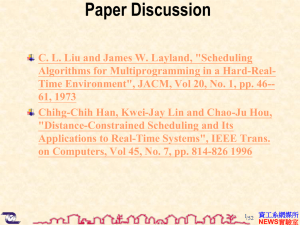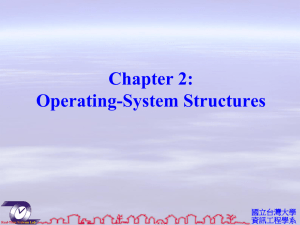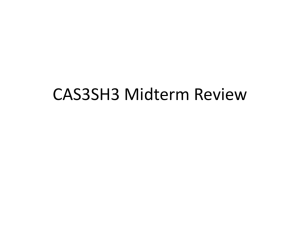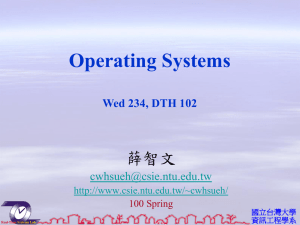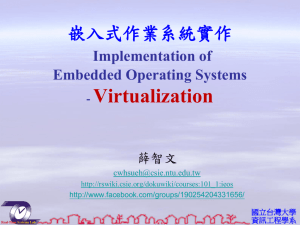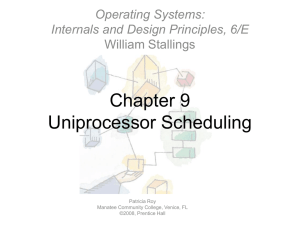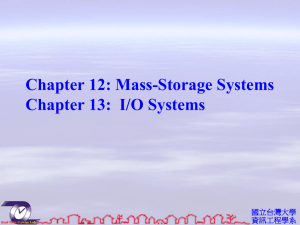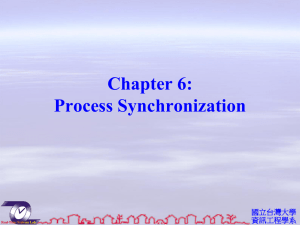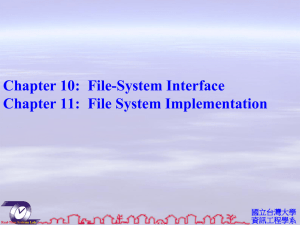資工系網媒所NEWS實驗室Chapter 5: CPU Scheduling
advertisement
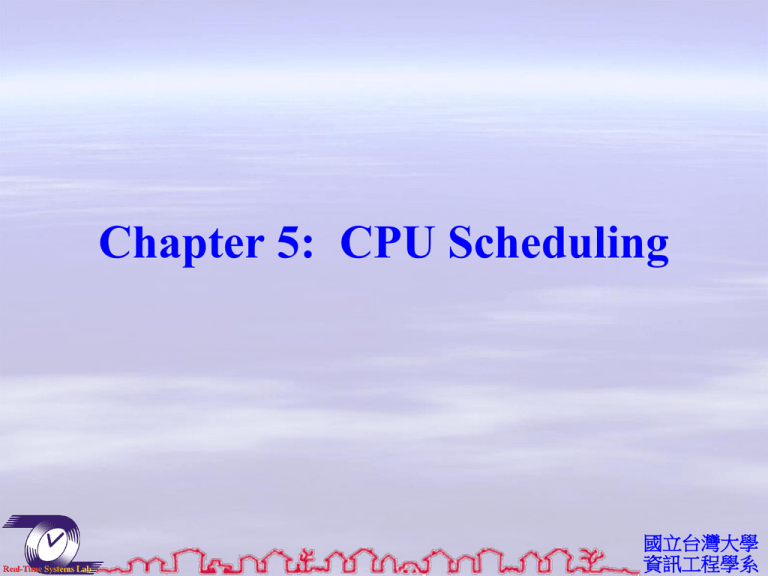
Chapter 5: CPU Scheduling
國立台灣大學
資訊工程學系
Objectives
To introduce CPU scheduling, which is the basis for
multiprogrammed operating systems
To describe various CPU-scheduling algorithms
To discuss evaluation criteria for selecting a CPUscheduling algorithm for a particular system
1 /45
資工系網媒所
NEWS實驗室
Chapter 5: CPU Scheduling
Basic Concepts
Scheduling Criteria
Scheduling Algorithms
Thread Scheduling
Multiple-Processor Scheduling
Operating Systems Examples
Algorithm Evaluation
2 /45
資工系網媒所
NEWS實驗室
Basic Concepts
Maximum CPU utilization
obtained with
multiprogramming
CPU–I/O Burst Cycle –
Process execution
consists of a cycle of CPU
execution and I/O wait
CPU burst distribution
3 /45
資工系網媒所
NEWS實驗室
Histogram of CPU-burst Times
4 /45
資工系網媒所
NEWS實驗室
CPU Scheduler
Selects from among the processes in memory that are ready to
execute, and allocates the CPU to one of them
CPU scheduling decisions may take place when a process:
1.
2.
3.
4.
Switches from running to waiting state
Switches from running to ready state
Switches from waiting to ready
Terminates
Scheduling under 1 and 4 is nonpreemptive
All other scheduling is preemptive
5 /45
資工系網媒所
NEWS實驗室
Dispatcher
Dispatcher module gives control of the
CPU to the process selected by the shortterm scheduler; this involves:
switching context
switching to user mode
jumping to the proper location in the user
program to restart that program
Dispatch latency – time it takes for the
dispatcher to stop one process and start
another running
6 /45
資工系網媒所
NEWS實驗室
Scheduling Criteria
CPU utilization – keep the CPU as busy as possible
Throughput – # of processes that complete their
execution per time unit
Turnaround time – amount of time to execute a
particular process
Waiting time – amount of time a process has been
waiting in the ready queue
Response time – amount of time it takes from when a
request was submitted until the first response is
produced, not output (for time-sharing environment)
7 /45
資工系網媒所
NEWS實驗室
Scheduling Algorithm Optimization Criteria
Max CPU utilization
Max throughput
Min turnaround time
Min waiting time
Min response time
8 /45
資工系網媒所
NEWS實驗室
First-Come, First-Served (FCFS) Scheduling
Process Burst Time
P1
24
P2
3
P3
3
Suppose that the processes arrive in the order: P1 , P2 , P3
The Gantt Chart for the schedule is:
P1
0
P2
24
P3
27
30
Waiting time for P1 = 0; P2 = 24; P3 = 27
Average waiting time: (0 + 24 + 27)/3 = 17
9 /45
資工系網媒所
NEWS實驗室
FCFS Scheduling (Cont.)
Suppose that the processes arrive in the order
P2 , P3 , P1
The Gantt chart for the schedule is:
P2
0
P3
3
P1
6
30
Waiting time for P1 = 6; P2 = 0; P3 = 3
Average waiting time: (6 + 0 + 3)/3 = 3
Much better than previous case
Convoy effect short process behind long process
10 /45
資工系網媒所
NEWS實驗室
Shortest-Job-First (SJF) Scheduling
Associate with each process the length of its next CPU
burst. Use these lengths to schedule the process with
the shortest time
Two schemes:
nonpreemptive – once CPU given to the process it cannot be
preempted until completes its CPU burst
preemptive – if a new process arrives with CPU burst length less
than remaining time of current executing process, preempt.
This scheme is know as the Shortest-Remaining-Time-First (SRTF)
SJF is optimal – gives minimum average waiting time for
a given set of processes
11 /45
資工系網媒所
NEWS實驗室
Example of Non-Preemptive SJF
Process Arrival Time
P1
0.0
P2
2.0
P3
4.0
P4
5.0
SJF (non-preemptive)
P1
0
3
P3
7
Burst Time
7
4
1
4
P2
8
P4
12
16
Average waiting time = (0 + 6 + 3 + 7)/4 = 4
12 /45
資工系網媒所
NEWS實驗室
Example of Preemptive SJF
Process Arrival Time
P1
0.0
P2
2.0
P3
4.0
P4
5.0
SJF (preemptive)
P1
0
P2
2
P3
4
P2
5
Burst Time
7
4
1
4
P4
7
P1
11
16
Average waiting time = (9 + 1 + 0 + 2)/4 = 3
13 /45
資工系網媒所
NEWS實驗室
Determining Length of Next
CPU Burst
Can only estimate the length
Can be done by using the length of
previous CPU bursts, using exponential
averaging
1. t n actual
length of n
2. n 1 predicted
th
CPU burst
value for the next CPU burst
3. , 0 1
4. Define :
n 1 t n 1 n
14 /45
資工系網媒所
NEWS實驗室
Prediction of the Length of the Next CPU Burst
15 /45
資工系網媒所
NEWS實驗室
Examples of Exponential Averaging
=0
n+1 = n
Recent history does not count
=1
n+1 = tn
Only the actual last CPU burst counts
If we expand the formula, we get:
n+1 = tn+(1 - ) tn-1 + …
+(1 - )j tn-j + …
+(1 - )n +1 0
Since both and (1 - ) are less than or equal to 1,
each successive term has less weight than its
predecessor
16 /45
資工系網媒所
NEWS實驗室
Priority Scheduling
A priority number (integer) is associated with each process
The CPU is allocated to the process with the highest priority
(smallest integer highest priority)
Preemptive
nonpreemptive
SJF is a priority scheduling where priority is the predicted next
CPU burst time
Problem Starvation – low priority processes may never
execute
Solution Aging – as time progresses increase the priority of the
process
17 /45
資工系網媒所
NEWS實驗室
Round Robin (RR)
Each process gets a small unit of CPU time (time quantum),
usually 10-100 milliseconds. After this time has elapsed, the
process is preempted and added to the end of the ready queue.
If there are n processes in the ready queue and the time
quantum is t, then each process gets 1/n of the CPU time in
chunks of at most t time units at once. No process waits more
than (n-1)t time units.
Performance
t large FIFO
t small t must be large with respect to context switch, otherwise
overhead is too high
18 /45
資工系網媒所
NEWS實驗室
Example of RR with Time Quantum = 20
Process
P1
P2
P3
P4
Burst Time
53
17
68
24
The Gantt chart is:
P1
0
P2
20
37
P3
P4
57
P1
77
P3
97 117
P4
P1
P3
P3
121 134 154 162
Typically, higher average turnaround than SJF,
but better response
19 /45
資工系網媒所
NEWS實驗室
Time Quantum and Context Switch Time
20 /45
資工系網媒所
NEWS實驗室
Turnaround Time Varies With The Time Quantum
21 /45
資工系網媒所
NEWS實驗室
Multilevel Queue
Ready queue is partitioned into separate queues:
foreground (interactive)
background (batch)
Each queue has its own scheduling algorithm
foreground – RR
background – FCFS
Scheduling must be done between the queues
Fixed priority scheduling; (i.e., serve all from foreground then
from background). Possibility of starvation.
Time slice – each queue gets a certain amount of CPU time
which it can schedule amongst its processes; i.e., 80% to
foreground in RR
20% to background in FCFS
22 /45
資工系網媒所
NEWS實驗室
Multilevel Queue Scheduling
23 /45
資工系網媒所
NEWS實驗室
Multilevel Feedback Queue
A process can move between the various queues;
aging can be implemented this way
Multilevel-feedback-queue scheduler defined by
the following parameters:
number of queues
scheduling algorithms for each queue
method used to determine when to upgrade a process
method used to determine when to demote a process
method used to determine which queue a process will
enter when that process needs service
24 /45
資工系網媒所
NEWS實驗室
Example of Multilevel Feedback Queue
Three queues:
Q0 – RR with time quantum 8 milliseconds
Q1 – RR time quantum 16 milliseconds
Q2 – FCFS
Scheduling
A new job enters queue Q0 which is served FCFS. When it
gains CPU, job receives 8 milliseconds. If it does not finish in
8 milliseconds, job is moved to queue Q1.
At Q1 job is again served FCFS and receives 16 additional
milliseconds. If it still does not complete, it is preempted and
moved to queue Q2.
25 /45
資工系網媒所
NEWS實驗室
Multilevel Feedback Queues
26 /45
資工系網媒所
NEWS實驗室
Thread Scheduling
Distinction between user-level and kernel-level threads
Many-to-one and many-to-many models, thread library
schedules user-level threads to run on LWP
Known as process-contention scope (PCS) since scheduling
competition is within the process
Kernel thread scheduled onto available CPU is
system-contention scope (SCS) – competition
among all threads in system
27 /45
資工系網媒所
NEWS實驗室
Pthread Scheduling
API allows specifying either PCS or SCS
during thread creation
PTHREAD SCOPE PROCESS schedules
threads using PCS scheduling
PTHREAD SCOPE SYSTEM schedules threads
using SCS scheduling.
28 /45
資工系網媒所
NEWS實驗室
Pthread Scheduling API (1/2)
#include <pthread.h>
#include <stdio.h>
#define NUM THREADS 5
int main(int argc, char *argv[])
{
int i;
pthread_t tid[NUM THREADS];
pthread_attr_t attr;
/* get the default attributes */
pthread_attr_init(&attr);
/* set the scheduling algorithm to PROCESS or SYSTEM */
pthread_attr_setscope(&attr, PTHREAD_SCOPE_SYSTEM);
/* set the scheduling policy - FIFO, RT, or OTHER */
pthread_attr_setschedpolicy(&attr, SCHED_OTHER);
/* create the threads */
for (i = 0; i < NUM_THREADS; i++)
pthread_create(&tid[i],&attr,runner,NULL);
29 /45
資工系網媒所
NEWS實驗室
Pthread Scheduling API (2/2)
/* now join on each thread */
for (i = 0; i < NUM_THREADS; i++)
pthread_join(tid[i], NULL);
}
/* Each thread will begin control in this function */
void *runner(void *param)
{
printf("I am a thread\n");
pthread_exit(0);
}
30 /45
資工系網媒所
NEWS實驗室
Multiple-Processor Scheduling
CPU scheduling more complex when multiple CPUs are
available
Homogeneous processors within a multiprocessor
Asymmetric multiprocessing – only one processor
accesses the system data structures, alleviating the need for
data sharing
Symmetric multiprocessing (SMP) – each processor is
self-scheduling, all processes in common ready queue, or
each has its own private queue of ready processes
Processor affinity – process has affinity for processor on
which it is currently running
soft affinity
hard affinity
31 /45
資工系網媒所
NEWS實驗室
NUMA and CPU Scheduling
32 /45
資工系網媒所
NEWS實驗室
Multicore Processors
Recent trend to place multiple processor cores
on same physical chip
Faster and consume less power
Multiple threads per core also growing
Takes advantage of memory stall to make progress
on another thread while memory retrieve happens
33 /45
資工系網媒所
NEWS實驗室
Multithreaded Multicore System
34 /45
資工系網媒所
NEWS實驗室
Real-Time Scheduling
Hard real-time systems – required to
complete a critical task within a
guaranteed amount of time
Soft real-time computing – requires
that critical processes receive priority
over less fortunate ones
Firm real-time computing – the timing
constraints can be changed on-line
35 /45
資工系網媒所
NEWS實驗室
Operating System Examples
Solaris scheduling
Windows XP scheduling
Linux scheduling
36 /45
資工系網媒所
NEWS實驗室
Solaris Dispatch Table
37 /45
資工系網媒所
NEWS實驗室
Solaris Scheduling
38 /45
資工系網媒所
NEWS實驗室
Windows XP Priorities
39 /45
資工系網媒所
NEWS實驗室
Linux 2.5 Scheduling
Constant order O(1) scheduling time, 2 queues
Two priority ranges : time-sharing and real-time
Time-sharing
Prioritized credit-based – process with most credits is
scheduled next
Credit subtracted when timer interrupt occurs
When credit = 0, another process chosen
When all processes have credit = 0, recrediting occurs
Based on factors including priority and history
Real-time
Soft real-time
Posix.1b compliant – two classes, FCFS and RR
Highest priority process always runs first
40 /45
資工系網媒所
NEWS實驗室
Priorities and Time-slice length
41 /45
資工系網媒所
NEWS實驗室
List of Tasks Indexed According to Priorities
42 /45
資工系網媒所
NEWS實驗室
Algorithm Evaluation
Deterministic modeling – takes a particular
predetermined workload and defines the performance
of each algorithm for that workload
Queuing models
n λW
Simulation
Implementation
n : queue length
W : waiting
time
: arrival rate
43 /45
資工系網媒所
NEWS實驗室
Evaluation of CPU schedulers by Simulation
44 /45
資工系網媒所
NEWS實驗室
End of Chapter 5
國立台灣大學
資訊工程學系

